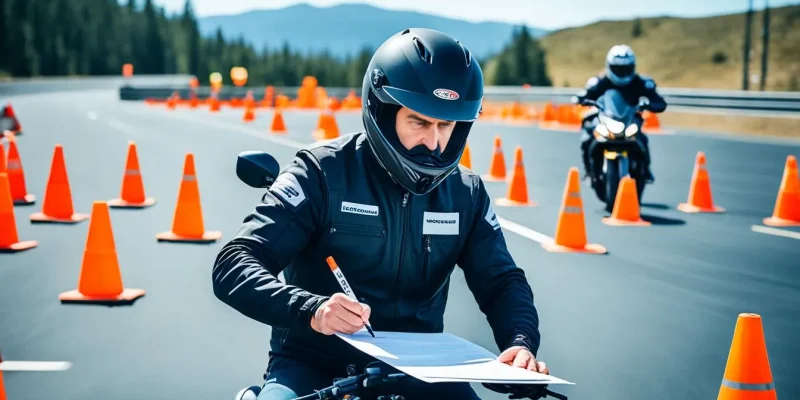The Motorcycle Driver Knowledge Test (DKT) is an essential step in earning your motorcycle licence in Australia. It’s designed to assess your understanding of the road rules, safety, and riding techniques. To help you succeed, we’ve put together some valuable tips to ensure you’re fully prepare to pass the test. Whether you’re a first-time rider or someone looking to refresh your knowledge, this guide will provide you with everything you need to pass the test with confidence.
1. Understand the Motorcycle DKT Format
The Motorcycle DKT is a computer-based test that typically consists of multiple-choice questions covering topics such as:
- Road safety and rules
- Traffic signs and signals
- Riding in various weather conditions
- How to handle dangerous situations
- Motorcycle equipment and maintenance
You’ll be required to answer a set number of questions, which may vary by state. The test is time, so it’s crucial to be efficient in answering. You can take practice tests to become familiar with the question format and to assess your knowledge.
2. Study the Official Motorcycle Handbook
The most reliable resource for studying is the official motorcycle handbook provided by your local licensing authority. This handbook covers everything you need to know, from basic road rules to specific safety requirements for motorcyclists. Make sure to:
- Read through the entire handbook
- Focus on chapters about road signs, traffic laws, and motorbike-specific regulations
- Pay special attention to sections about riding safety, including protective gear, speed limits, and hazard identification
To ensure that your knowledge is up-to-date, always refer to the official state or territory website for the latest information.
Official Handbook (NSW): Roads and Maritime Services (RMS)
3. Take Practice Motorcycle DKT Test
One of the best ways to prepare for the Motorcycle DKT is to take practice tests. These mock exams simulate the real test and will help you become familiar with the format, types of questions, and time pressure. Many official websites, as well as third-party sites, offer free practice tests.
- Focus on identifying common questions that appear in previous tests
- Set a timer to simulate exam conditions and improve your time management skills
- Review the answers you get wrong and study the related topics to reinforce your knowledge
By practicing regularly, you’ll build confidence and get a better sense of which areas you need to focus on before your test day.
4. Learn Road Signs and Signals
Motorcycle riders must have a solid understanding of road signs and signals. These signs are crucial for making safe decisions while on the road. Here are a few categories to focus on:
- Warning signs: These signs alert you to potential hazards like sharp curves, intersections, or slippery roads.
- Regulatory signs: These signs give instructions or rules, such as speed limits and no-entry signs.
- Informational signs: These include signs indicating fuel stations, food stops, or hospitals nearby.
Ensure that you not only recognize these signs but also understand how to react when you encounter them while riding. This knowledge is frequently tested on the Motorcycle DKT.
5. Review Safe Riding Techniques
Your safety and the safety of others on the road should be a top priority. The DKT tests your knowledge of safe riding practices, which include:
- Protective gear: Always wear proper motorcycle gear like helmets, gloves, jackets, pants, and boots. Learn about the various types of protective equipment and their importance.
- Defensive riding: Understand how to ride defensively by scanning the road, anticipating potential hazards, and maintaining a safe following distance.
- Road positioning: Learn how to position yourself on the road to maximize visibility and control, particularly when riding in traffic or around corners.
- Handling hazards: Understand how to deal with common road hazards like gravel, wet roads, and other vehicles.
The Motorcycle DKT evaluates your knowledge of these techniques, so make sure you’re fully prepared.
6. Know the Licensing Requirements
Each state and territory in Australia has its own licensing process for motorcycle riders, so it’s important to familiarize yourself with the specific requirements in your area. In some regions, you may be required to complete a practical riding test after passing the DKT. Other requirements might include:
- Age restrictions
- The number of practice hours required before applying for a full licence
- Minimum engine capacity for the learner’s motorcycle
Make sure you’re aware of the full process in your state to avoid any surprises down the line.
7. Stay Calm and Confident on Motorcycle DKT Test Day
On the day of your test, remember that staying calm and focused is essential. Here are a few last-minute tips:
- Get plenty of rest the night before the test to ensure you’re mentally sharp.
- Arrive early so you have time to settle in and review any last-minute notes.
- Read each question carefully during the test. Don’t rush through it—take your time to ensure you understand what is being asked before selecting an answer.
If you’ve studied thoroughly, you’ll be prepared to tackle the test confidently.
Conclusion
Passing the Motorcycle DKT is a vital step in becoming a skilled and responsible rider. By thoroughly studying the official motorcycle handbook, practicing with mock tests, and focusing on safe riding techniques, you can set yourself up for success. Remember, preparation is key to passing the test and becoming a safe motorcycle rider.
Good luck with your Motorcycle DKT Test!

